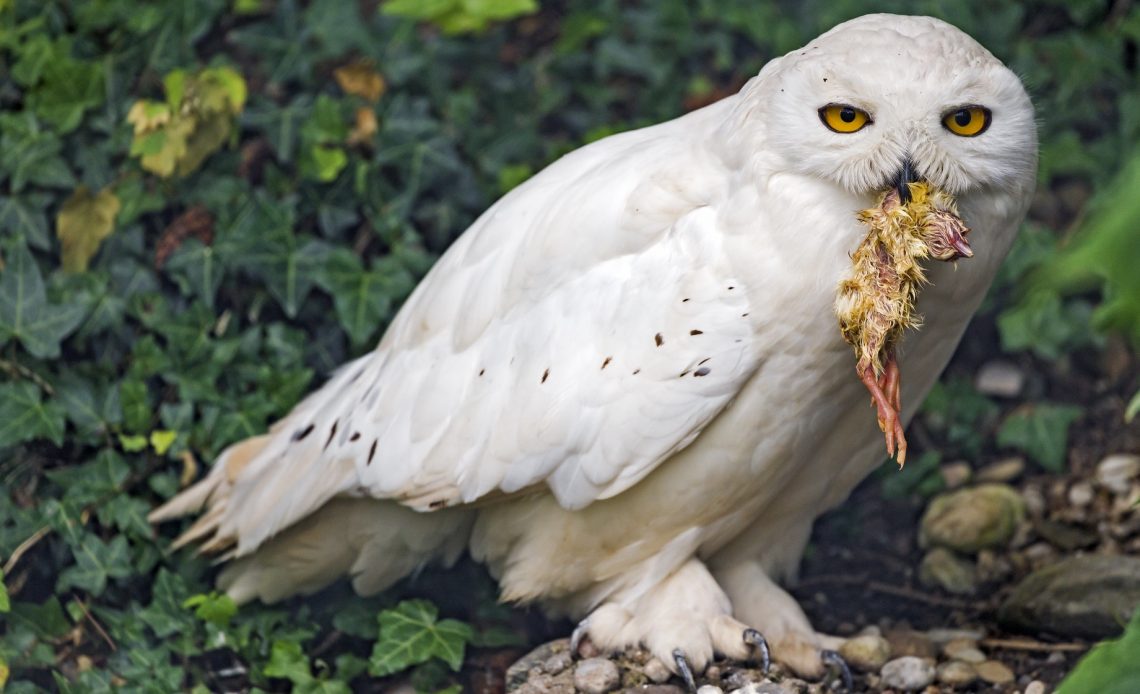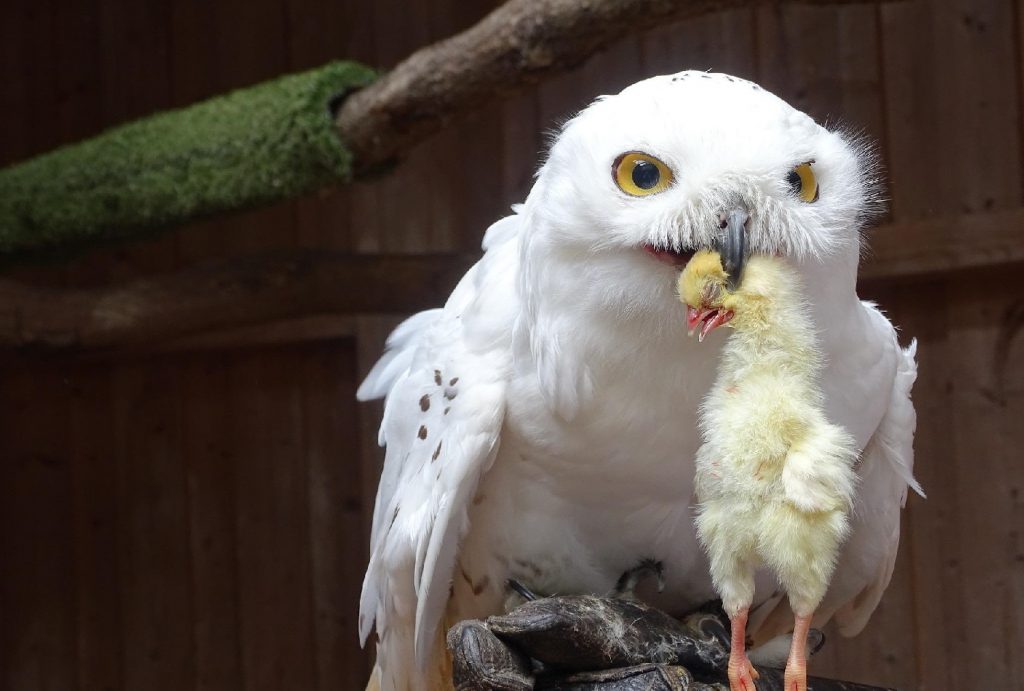

We’re here to help! Wild Yards is a completely free website that is 100% dedicated to helping you create a wildlife-friendly, sustainable yard. Read more
WildYards is reader-supported. When you buy a product through a link on our site, we may earn a comission. Every product is independently selected by our (obsessive) editors and our reviews are unbiased and objective. Read more about our mission or our privacy policy.
As an avid birdwatcher, you’re probably eager to attract local songbirds to your backyard. But this can be a double-edged sword because when you attract one kind of bird, other more aggressive birds may not be far behind. You want to enjoy the sights and sounds of tanagers, cardinals, and jays, but you don’t want to invite predatory birds to your garden as well. So, do owls eat birds?
Yes, owls will prey on other birds. As carnivores, owls rely on a variety of prey to survive. While most of their prey generally consists of rodents, owls will feed on many birds and raid their nests, too.
Why do owls eat birds instead of other prey?
Owls will prey on whichever animals and insects they can. They’ll catch crayfish, frogs, and fish as well as gophers, rats, snakes, and squirrels. Large owls, like the eagle owl (also known as the Eurasian owl), will prey on larger prey, like rabbits. These owls are strong and sturdy, typically weighing around nine pounds, so subduing bigger prey is no problem for them.
Other owls, like the barn owl, are much smaller weighing in at just under two pounds on average. As a result, they prefer to sneak up on smaller prey that’s easier for them to handle like mice, voles, and lizards. Smaller owls are well-suited to dealing with little prey like these animals.
Regardless of whether or not an owl is large or small, if it gets an opportunity to prey on another bird, it will. Owls also like to steal other birds’ eggs right out of their nests. They won’t turn their beaks up at baby birds, either. These raptors are opportunists in the purest sense. They’re happy to eat anything they can catch, and that includes other members of their species.
Which birds do owls eat?
The answer to that question is pretty simple: any and all of them. From your average backyard songbirds, like cardinals, tanagers, and sparrows to larger birds like magpies, ravens, and ducks, owls will stalk a bird anytime the mood strikes them. They’re notorious for preying on chickens, too, which makes protecting your own flock all the more important.
Remember, owls eat prey that is proportionate to their size. You probably won’t see a Ferruginous pygmy owl, which is small enough to rest on your index finger, trying to tackle a crow. But bigger owls, like the barred owl or the great horned owl, will take on a blackbird given the chance.
Indeed, large owls have been known to go after other predatory birds, including osprey, hawks, and even other owls! And, as if these raptors weren’t big enough prey, some owls will hunt geese. Canada geese are sometimes the object of an owl’s unwanted attention, and these waterfowl weigh around 12 pounds. So it seems some owls aren’t the least bit deterred by a potential prey’s size.
While it’s not unheard of for an owl to attack another bird many times its own size, they usually go for the small stuff. Wrens, finches, woodpeckers — these birds are about the size of a rat or large mouse. They’re not too difficult for a skilled hunter to capture and they make for a decent meal.

How do owls digest the birds they prey on?
When an owl eats its prey, the food immediately enters the stomach, which has two parts. The first stomach is the glandular stomach, or the proventriculus. This stomach creates the acids and enzymes needed to break the owl’s food down so it can be used for energy.
The second part of an owl’s stomach is called the ventriculus, or, more commonly, the gizzard. The gizzard is the muscular stomach, and it stores all of the leftover parts of the owl’s meal that cannot be broken down — bones, beaks, teeth, fur. You get the picture.
Once the owl’s digestive system has broken the meal down, it allows the soluble foods to continue to pass through the intestines and exit through the back end, or the cloaca. Meanwhile, the undigestible remnants are packed together in the gizzard to create a large pellet, which the owl disposes of via regurgitation, a process that can take around 10 hours. Pretty cool, huh? Well, it’s also highly disgusting. But, that’s nature for you!
Do other birds eat owls?
Owls are fearsome predators, but if another predatory bird is around, they may have the tables turned on them. Hawks, eagles, and falcons will eat owls on occasion. After all, they’re opportunistic hunters, too. But owls have several things working in their favor to give them an advantage over their would-be predators.
To start with, owls are mostly nocturnal. Some owls, like the short-eared owl, prefer to hunt during the day. And, individually, an owl may decide to wake up for a mid-day snack. But, for the most part, owls are not around when other predatory birds are out and about. They’re tucked away in their nests, safe from other raptors.
Vultures, too, will eat owls. But, as scavengers, these birds don’t hunt down their prey. They just feed on animals that have already died. And if that animal happens to be an owl, well, then so be it. Vultures eat roadkill, after all. They’re not too picky.
Mockingbirds, crows, and jays may not eat owls, but they like to antagonize them every chance they get. If these birds spot an owl in the vicinity, especially if it’s near their nests, they’ll gang up on the owl and run him out of town like a posse in an old western. These birds may be pretty small compared to an owl, but they’re nothing if not confident. When it comes to defending their territories from other birds, they mean business!
How can you prevent owls from eating your local birds?
If you want to let your backyard grow wild, good on you! Letting nature take back as much as it can will help keep your local ecosystem booming. But this process can be a balancing act. On the one hand, you want to bring in as much wildlife as possible. On the other hand, you don’t want the animals that are higher up on the food chain to view your backyard paradise as their own personal smorgasbord.
If you want to rein in the neighborhood owls, try attracting more crows, jays, and mockingbirds. Use these birds’ natural anti-owl instincts to your own advantage. You can bring more of these birds to your backyard by setting up a peanut bird feeder. Installing a bird bath can help, too. When you can get more owl antagonists to patrol the area, the problem may resolve itself.
Owls also dislike humans. So try to be in your backyard around dusk, when they start their nightly hunt. If they see you out in your garden, they’ll be less likely to swoop in for a snack. Meanwhile, the songbirds will realize that you’re keeping the owls at bay, and use the opportunity to hit up your bird feeders.
Owls eat other birds, and they do so regularly. If you want to continue to attract songbirds, you can limit owl visitors by appealing to the birds that antagonize them and by increasing your presence in your backyard. This will help restore nature’s healthy balance so you can continue to enjoy hosting a variety of local wildlife!
